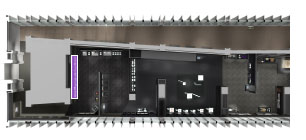3-2-6-1The breakdown of Family N
The depths of illness and poverty August 6, 1951
Even in mid-summer, N sat in a darkened room with the door shut.
Unbearable pain
If N didn’t work, the family would starve to death. When he worked, he would writhe in unbearable agony. This endless, vicious cycle was hard to face.
Children abandoning home
By 1957 N had been rejected by all the local hospitals. He returned home. He gradually gave up on himself. Giving up on their depressing family, some of his children left home.
Collapsing family
N was suffering great pain, but nothing the family could do relieved it. He sought medical care at nine different hospitals after 1952 and underwent two major operations, but his condition never improved. Hiroshima City officials thought he was faking his illness and classified him a mental patient.
Hope for recovery
N was admitted to the A-bomb Hospital in 1960. He had been treated badly before when hospitalized with his ragged futon (Japanese bedding). Not wanting him to repeat that bitter experience, his daughter borrowed money and made a new futon. His mother bought him new pajama.
Leaving hospital in despair
One month after admission, N came home having received no effective treatment. He brought a white plaster cast home with him. He said indignantly, “I was told to put this on my back and stay in bed because there’s nothing else they can do for me.”
The end of the N family breakdown 1960
N’s daughter was at a loss. “I don’t know what to do anymore.”
After being discharged, N lost the will to live.
N died on January 1, 1967. Well over a hundred scars were found on his thighs. He had repeatedly cut himself with a razor during his 22-year ordeal. When he could no longer stand the agony, he distracted himself. N’s death brought an end to the family breakdown.
Living with improperly functioning bodies
Many survivors lost their jobs and struggled through a hand-to-mouth existence. They suffered from the lack of understanding of A-bomb diseases. They faced discrimination and the false assumption that A-bomb diseases were contagious. Even when they had a job, many tired easily and had to take frequent breaks. People said they had Bura bura byo (idlers’ disease) and treated them with cold disdain.
- Location
-

Reality of the Atomic Bombing 3 Victims and Survivors
3-2-6 The Breakdown of Family N



